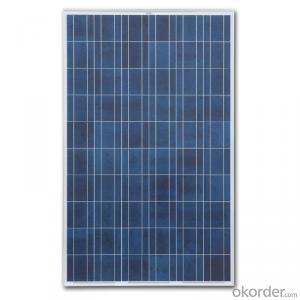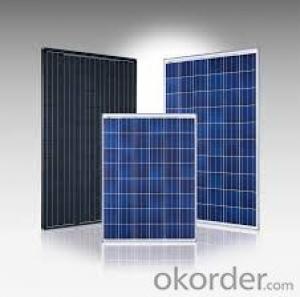Crystalline Si Solar Cells - Factory Wholesale Polycrystalline Solar Panel CNBM
- Loading Port:
- Qingdao
- Payment Terms:
- TT OR LC
- Min Order Qty:
- 10 set
- Supply Capability:
- 300000 set/month
OKorder Service Pledge
OKorder Financial Service
You Might Also Like
Polycrystalline Solar Modules
CNBM offers a range of small, medium and large polycrystalline solar modules, designed for a range of requirements.


Specifications:
Tolerance | +/-3% |
Cell | Polycrystalline silicon solar cells (156 x 156mm) |
N0. of Cells | 60 (0 x 6) |
Dimension of Modules (mm) | 1650 x 990 x 40 |
Weight (kg) | 25.5 |
Limits:
Operating Temperature | -40~+85? |
Storage Temperature | -40~+85? |
Maximum System Voltage | 1000 VDC max. |
Hail Impact | Diameter of 28mm with impact speed |
Temperature and Coefficients:
NOCT | 48C+/-2? |
Voltage temperature coefficient (%/K) | -0.35 |
Current temperature coefficient (%/K) | 0.05 |
Power temperature coefficient (%/K) | -0.45 |
Characteristics:
Model: | SGM-200P | SGM-210P | SGM-220P |
Max-power voltage Vmp (V) | 29.2 | 29.4 | 29.41 |
Max-power current Imp (A) | 6.85 | 7.14 | 7.48 |
Open-circuit voltage Voc (V) | 36.5 | 36.69 | 36.9 |
Short-Circuit Current Isc (A) | 7.28 | 7.6 | 7.93 |
Max-power Pm(W) | 200 | 210 | 220 |
Model: | SGM-230P |
Max-power voltage Vmp (V) | 29.8 |
Max-power current Imp (A) | 7.72 |
Open-circuit voltage Voc (V) | 37.31 |
Short-Circuit Current Isc (A) | 8.19 |
Max-power Pm(W) | 230 |
STC: Irradiance 1000W/m2, module temperature 25?, AM-=1.5
Poly Crystalline Solar Panels Specifications Range
Maximum Power (Pm) | Dimension | Weight | Operating Voltage (Vmp) | Operating Current (Imp) | Open Circuit Voltage (Voc) | Short Circuit Current (Isc) |
0.45W | 140x80x10mm | 0.08kg | 3.3V | 150mA | 4.6V | 160mA |
1.0W | 162x140x10mm | 0.16kg | 7.5V | 150mA | 10.3V | 160mA |
4.5W | 269x251x23mm | 0.8kg | 16.5V | 0.27A | 20.5V | 0.3A |
10W | 420.1×268.9×22.6mm | 1.92kg | 17.5V | 0.58A | 20.5V | 0.6A |
20W | 425x502x50mm | 3.0kg | 16.8V | 1.19A | 21.0V | 1.29A |
30W | 593x502x22.6mm | 3.9kg | 16.8V | 1.78A | 21.0V | 1.94A |
40W | 655x537x50mm | 5.75kg | 17.3V | 2.31A | 22.1V | 2.54A |
50W | 839x537x50mm | 6.0kg | 17.5V | 2.9A | 21.8V | 3.17A |
65W | 1111x502x50mm | 7.2kg | 17.6V | 3.69A | 22.1V | 3.99A |
80W | 1204x537x50mm | 7.7kg | 17.6V | 4.55A | 22.1V | 4.8A |
- Q: Briefly explain why solar cells are made into components
- Components are made in order to better protect the crystalline silicon material is not destroyed, the components generally by the tempered glass, EVA, battery, TPT, aluminum frame and other materials, so that the components, the service life of up to 20 years The
- Q: PV: the battery to the battery charge problem
- I use the BUCK circuit, controlled by the microcontroller, the circuit is not too difficult, are ready, but the understanding of BUCK problems. See a lot of books are written on the battery can be constant pressure charging, feeling can not understand. Now I think they are probably wrong, the voltage across the battery in the BUCK circuit is out of control.
- Q: How do solar cells perform in areas with high levels of insect activity?
- Solar cells can be affected by insects in areas with high levels of insect activity. Insects can cause shading on the surface of solar panels, reducing their efficiency. Additionally, insect debris and waste can accumulate on the panels, further decreasing their performance. Regular cleaning and maintenance can help mitigate these issues and ensure optimal performance of solar cells in such areas.
- Q: Solar panel resistance is changed with what
- To be sure that this question is very professional. Secondly, I have to answer this question: the internal resistance of solar energy, mainly reflected in the power generation, the inhibition of current. In the time of power generation,
- Q: Can solar cells be used to power medical devices?
- Yes, solar cells can be used to power medical devices. Solar cells, also known as photovoltaic cells, convert sunlight into electricity. This renewable energy source can be harnessed to power various medical devices such as portable glucose monitors, prosthetics, hearing aids, and even small medical implants. Using solar cells to power medical devices offers a sustainable and convenient solution, especially in remote areas or during emergencies where access to electricity may be limited.
- Q: Is that true that the price of solar cells will be reduced in the coming year?
- There are some policy change from the central government that financial subsidies of purchasing solar cells from the government will be lowered compared to last year. This could be a big reason for the price going down.
- Q: How do solar cells handle electromagnetic radiation?
- Solar cells handle electromagnetic radiation by converting it into electrical energy. When sunlight (which is a form of electromagnetic radiation) strikes the solar cell, it excites electrons, allowing them to flow through the material, creating an electric current. The materials used in solar cells are designed to efficiently absorb and convert a wide range of electromagnetic radiation, including visible light and some parts of the infrared and ultraviolet spectrum.
- Q: What is the best sales solution for solar power cells?
- I highly recommend you to put your solar power cells for sales on the B2B website, such as alibaba in China. Because in this way, your product can be seen by many buyers.
- Q: Can solar cells be used on boats?
- Yes, solar cells can be used on boats. They are a popular and sustainable source of energy for powering various systems on boats, including lighting, navigation equipment, and charging batteries. Solar panels can be easily installed on the deck or roof of a boat to harness sunlight and convert it into electricity, reducing the reliance on traditional fuel sources and offering a clean and renewable energy solution.
- Q: Can solar cells be used in clothing?
- Yes, solar cells can be used in clothing.
Send your message to us
Crystalline Si Solar Cells - Factory Wholesale Polycrystalline Solar Panel CNBM
- Loading Port:
- Qingdao
- Payment Terms:
- TT OR LC
- Min Order Qty:
- 10 set
- Supply Capability:
- 300000 set/month
OKorder Service Pledge
OKorder Financial Service
Similar products
Hot products
Hot Searches
Related keywords

























